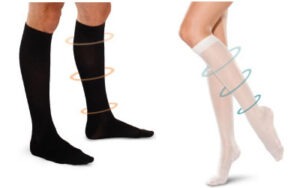Compression socks are specially designed stockings that squeeze around your legs and at various lengths gently.
From their medical benefits to the misconceptions about the appropriate age to use these compression socks, there is abundant information that you need to acquire.
If you are searching for information about compression socks, this is the right article for you since it will give you in-depth information about compression socks.
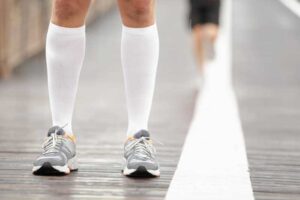
What Are They?
Compression stockings or compression socks are socks of different lengths that are made to gently squeeze your legs a bit more than your typical socks.
Your circulatory system pumps oxygenated blood through your arteries and veins from your heart. When the oxygenated blood is distributed in your entire body, the oxygen is depleted and the blood has to pass through different veins in and back to the heart for replenishment.
The blood in your legs’ veins has to work against gravity to reach the heart. Due to this reason, your arteries and veins in the legs tend to get weaker and in turn, become inefficient. This is where your compression socks come in.
Compression socks put pressure on your calves and ankles by gently and continuously squeezing on the bottom of the circulatory system thus helping to support your veins when sending deoxygenated blood back up to the heart.
What Do Compression Socks Help With?
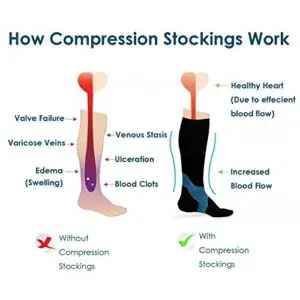
Compression socks are designed of elastic fibers that are made strong at your ankles and feet and continue upwards towards your knees. They counteract the effect of blood pooling and lymphatic fluid blood in your lower proximities. Compression socks work by applying pressure on your ankles and calves which helps in:
- Reducing the diameter of your major veins by increasing the velocity and volume of blood flow.
- They help to stop blood from refluxing to your foot or laterally to your superficial veins.
- Compression socks assist your blood to flow upwards towards your heart.
Why Wear Them?
Below are the reasons for wearing your compression socks:
-
It is a growing trend.
Compression socks used to be solely meant for medical treatment for individuals with poor circulation as well as other issues with their legs. Nowadays, everyone including pregnant women and athletes as well as other individuals wears compression socks.
-
Support during pregnancy.
Pregnant women experience situations of diminished blood flow since the growing infants put pressure on the mother’s veins and the physical activity is reduced during this time.
Compression socks do wonders in combating the swollen ankles and feet during pregnancy making them a necessity for these mothers.
-
Fight off varicose veins.
Varicose veins are genetic, but with compression socks, you can stop them from becoming worse. Compression socks enhance circulation since Varicose veins result from lessened blood flow and weakened valves. The veins are given the surge of oxygen that they need.
You should speak to your doctor before trying to treat your condition with compression socks since some of the cases might need medical intervention.
-
Make your workday get less strenuous.
When you sit in your workplace with your computer all day or you tend to move a lot then compression socks will work well with you. Compression socks give support against swelling as well as the aforementioned DVT.
Additionally, doctors, teachers, flight attendants as well as servers should wear compression socks to stop or avoid swelling of the ankles and sore muscles since they are always standing for most of the day.
-
Your long-haul flights get safer and even more comfortable.
If you have ever been on a plane, you are familiar with the discomfort that comes when sitting in a seat in a cramped seat. Spending hours on high altitudes without moving your legs can lead to issues worse than sore muscles.
When a plane ascends, oxygen in the cabin is lost and this can thicken your blood. Passengers who do not get out of the seats are put at risk of suffering deep vein thrombosis which is a life-threatening blood clot.
To fight this issue, doctors usually recommend that individuals wear compression socks while on planes. This will promote blood flow and also stop the uncomfortable in-flight swelling.
When to Wear?
Compression socks are a great deal and you should wear them when:
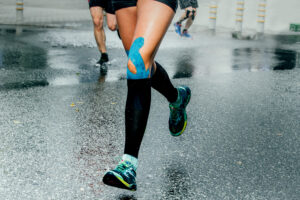
-
For exercising.
What compression socks will do is to help you with post-exercise recovery as well as reduce soreness. According to experts, wearing your compression socks lessens the soreness in your legs.
-
For traveling.
The risks of experiencing blood clots or deep vein thrombosis increase when traveling in an airplane. With your compression socks, these risks are prevented and also you keep your legs feeling fresh after arriving at your destination.
-
For fashion.
From business casual to athletic or fashion, both off-the-shelf and medical compression socks come in a wide range of styles and materials. Whether you want something for enjoying the aesthetic or something sharp for your work, compression socks are just as good as they feel.
Can Wearing Compression Socks Be Harmful?
Generally, compression socks are very safe to wear, but only if done in the right manner. Some individuals should not use compression socks including those with easily irritated or delicate skin. Below are some of the risks associated with compression socks that you should know:
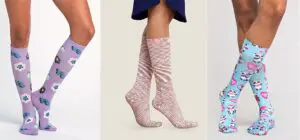
– Can bruise and chafe your legs.
If your skin is dry, or you are traveling in a dry air climate, such as in an airplane, it is more likely that your skin will scrape or chafe. Individuals with compromised skin may experience bruises, scrapes, or cuts from compression socks.
However, if your compression stockings or socks are properly fit, then you might not experience these conditions.
– Cut off your circulation.
Compression stockings and socks are designed to give continuous pressure that will support circulation. But if the socks are not fitted properly, then the opposite can happen and prevent the blood from circulating in the legs.
– Can cause irritation, itching, and redness.
Compression socks can provoke skin irritation and bring about itching. When your compression socks are not properly fitted, temporary dents and redness in your skin might appear in your calves and at the edge of your sock’s fabric.
What Types Do I Need?
Compression stockings come in three primary types which are:
-
Graduated compression stockings.
The level of compression in graduated compression stockings is strongest at your ankles and decreases gradually towards the top. These stockings are made for mobility and also to meet a particular length and strength for medical specifications.
Graduated compression stockings need a professional fitting. The stockings that end below your knee assist in limiting peripheral edema and lower your lower leg swelling as a result of fluid buildup. If your stockings extend to your waist or thighs, they help minimize the pooling of blood in your legs as well as helping to prevent orthostatic hypotension.
-
Anti-embolism stockings.
The anti-embolism type of stockings minimizes the possibility of developing deep vein thrombosis. Just like the graduated stockings, these types give gradient compression. Although, the level of compression varies. Anti-embolism stockings are made for individuals who are not mobile.
-
Nonmedical support hosiery.
Elastic support hose and flight socks are sold as a possible relief for your aching and tired legs. These types of socks bring uniform compression that puts less pressure than your prescription compression stockings and can be bought online or at a pharmaceutical store.
What Are the Side Effects of Compression Socks?
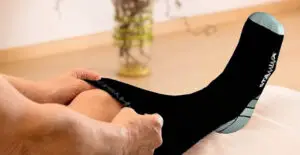
If the doctor has prescribed compression stockings, then you should check the legs daily for skin irritation, changes, or redness. These side effects indicate that:
- You have an infection.
- Your stockings do not fit you properly.
- You are not taking off or putting on your stocking properly.
- You might be allergic to your compression stockings materials.
The biggest question is how to avoid these side effects.
– Do not overwear them.
The biggest side effect of your compression stockings results from overwearing them. Ensure that you do not wear them while sleeping or wearing them for long hours. Take them off after every 2 hours for some minutes to allow your skin to breathe thus avoiding skin diseases and infections.
– Select the correct pressure level.
Ensure that you choose the right compression pressure level suitable for your health conditions as well as your needs.
– Go through the sizing chart and choose the perfect size.
If you are suffering from redness and irritation as a result of wearing your compression stockings, check if you purchased the right size. Ensure that they are measured correctly to stop any possible loss of circulation.
– Wear them the right way.
Ensure that you are putting on and removing off the compression stockings in the right way.
How Do You Know What Compression Socks to Buy?
There are many varieties of compression stockings and socks that differ in style, size, material length as well as compression level. If your compression socks are a prescription from your doctor, then he/she is the best resource that you have.
Here are several factors on determining what kinds you should choose,
-
Size.
Most retailers give measuring charts to direct you on how to choose the right size for you. The sizing systems depend on the type of compression socks you want. For instance, over-the-knee or knee socks will take into account the shoe size.
The full compression pantyhose are sized as regular and department store pantyhose. The sizing is based on the ratio between your weight and height. Some might need the measurements for calf circumference, ankle circumference, thigh circumference, calf length, and thigh length.
-
Material.
The material and style that you choose depend on the reason for wearing your compression socks. Some socks are made of lycra, spandex, or rubber and they feature different lengths like full, thigh, or knee.
If the compression socks are for medical purposes, consult with your doctor, but if you are wearing them since you stand for extended periods or you sit for long hours, choose what is comfortable for you.
Recommend reading: Best Material for Socks – Soft & Comfortable
-
Compression.
The level of compression of your socks depends on what reason makes you wear your compression socks.
The standard levels of compression socks include:
- Light to moderate compression
- Moderate compression
- Firm compression
- Extra firm compression
- Heavy compression
Then how do I know what levels do I need? Apart from levels of socks, you should also know what each level points to, and go on reading, you will find the answers.
What Does mmHg Mean and What Size Do I Need?
Accurate sizing and measurement of your compression socks enable maximum effectiveness and support. The simple steps below will help you choose the perfect size of your compression socks.
- 15-20 MMHG
These are everyday compression socks and they give relief to anyone who is experiencing achy, tired legs, or mild swelling. They are great for travel, work, and pregnancy.
- 20-30 MMHG
These are medical compression socks to offer more support and also prevent moderate to severe pain in your legs and swelling. This compression level also prevents Varicose veins and deep vein thrombosis.
- Step-by-step on how to measure the size of your compression socks:
Step 1: Measure the circumference of your ankle, that is, at the narrowest part of your ankle. This is above your ankle bone.
Step 2: Measure the circumference of your calf at its widest part.
Step 3: Measure the length of your calf. The measurement should be taken from the outside of your leg, by measuring from the ground up to where your knee bends.
Step 4: Use the sizing chart of your preferred compression to choose your size.
Step 5: Ensure that your sock band lies flat while the top of your band sits two fingers width down the crease of your knee. You should not pull your sock up into your crease behind the knee since this limits circulation.
Best Way to Put It on and off
1. Step-by-step on how to put on your compression socks:
Step 1: Prepare to put on your compression socks.
To get started, it is best to wear your compression socks in the morning. Make sure that your legs and feet are completely dry. You can decide to use baby powder or talcum powder to minimize friction.
It would be nice if you bought a donning glove when wearing your compression stocking. If your compression socks are open toe, you will only need a foot-slip that is included in the package.
After availing of all the mentioned items, make sure that your feet and toes are oriented to your leg before starting to wear your socks.
Step 2: On your foot.
The next step is to pull the compression socks over your foot until your ankle is fully covered. Have some materials such as a foot slip over the ball of your foot. Steadily pull the materials past your heel over the ankle and move the material up your leg gradually. For the open toe sock putting on the foot, slip helps limit the friction that might occur under your heels and toes.
Step 3: Over your foot.
Gradually pull some materials under your possession over the ball of your foot and the toes. Next, after bringing some materials on foot, pull the materials over the ankle and the heel gradually. Since you have eased the socks over the foot and heel and up your calf, pay attention to the placement of the heel’s stockings. Ensure that you center the heel of your stocking effectively.
Step 4: In case you are wearing the open toe stocking, here you will be required to pull the foot slip from the foot. If you are not sure, then move to the next step.
Step 5: Final stage.
Confirm that the top band of your socks is in position. For knee-high lengths, your top band has to be two fingers beneath the bend of your knee. However, for thigh-high lengths, allow the top band to be at the top of your thigh. For open toe socks, the band should rest on the base of your toes comfortably. Adjust either backward or forward according to your preference.
2. Taking off your compression stockings.
You have to remove your compression stockings after long hours in your workplace or when getting to your bed. Below are the steps of taking off your compression socks:
Step 1: Turn inside out:
To remove the compression socks, you have to roll the top band inside-out and then peel the socks away from the leg. This prevents the material from clumping up at your ankle region.
Step 2: Gradual pulling.
Continue pulling your socks off the legs and feet. Do not do it forcefully. Short pulls help you to get the stockings off the feet without overstretching the material which can damage it. After the compression stockings are out, now you can wash them.
How Long Should You Wear Compression Socks?
You can wear your compression socks every day and all day. Compression socks are designed to be worn for extended periods whether you are traveling in an airplane, working on the night shift, or sitting at your office all day.
Just ensure that you remove the compression socks anytime you want to sleep.
For you to determine how long you will spend wearing the compression socks, first consider the symptoms that you had experienced.
- If you want to eliminate fatigue after your workout, then you can consider wearing your compression socks in 4 hours immediately following an exercise.
- If you are minimizing swelling, put on your compression socks before the long duration of standing.
- If you are wearing your compression socks for medical reasons, it would be best if you asked your doctor or a medical professional to know the time you should put on your compression socks to treat your conditions.
How to Fit Compression Socks?
Your compression socks should feel snug without being painfully tight.
To help fit your compression socks, you can purchase a stocking doner, it is great if you are suffering from arthritis thus finding it difficult to put on your compression socks.
You should also use the size chart to assist you to get the compression socks that fit you.
Special Tips on Wearing Compression Socks for New Wearers.
To make compression stocking and socks user friendly and mostly for new wearers, follow the special tips below:
-
Start in the morning.
Your legs are least inflamed or swollen in the morning thus the best time to put on your compression socks and will be much easier. Therefore, put on your compression stockings when you get out of bed.
-
Prepare your legs.
During winter, the weather is dry and many people will add a thin layer of their baby powder or lotion to their legs and calves to make it easier to put on their compression socks.
If it still proves difficult, you wear rubber gloves, just like those you put on when you are washing your dishes, to maintain a grip on your stockings.
-
Check pressure.
Your compression stockings should feel tightest in your ankles and his pressure should decrease up your calves. For properly fit compression socks, they should be around 2 inches beneath your knees and the heel of your stockings should look like your heel. If the pressure is even in the entire compression socks or does not fit you properly, talk to a medical professional.
-
Daily checks.
Your compression stockings can move around during the day. Therefore, you should check your socks periodically during the day.
-
Proper care.
The bigger part of wearing your compression socks is how you take care of them. If you take good care of your compression socks, they can serve you for six months.
Frequently Asked Questions.
1. How tight should compression socks be?
The pressure of your socks depends on your goals. Whether you are looking to eliminate or prevent spider veins when pregnant or you want to improve your athletic performance and in other cases to prevent blood clots in your veins. Compression socks come in pressure levels of millimeters of mercury. You can choose the pressure level from 8 mmHg to 40mmHg. Choose a level that addresses your health goal as well as minimizing discomfort. Generally, your compression socks should fit snugly.
2. How to wash them?
Below are steps of how to wash your compression socks:
- Soak your compression socks in a tub that is filled with cool water.
- Rub any oil or dirt that you see gently.
- Avoid stretching your socks vigorously when you submerge and then lather them.
- Rinse your socks gently until all the water squeezes out to eliminate any detergent or soap.
- Avoid wringing your socks.
- Squeeze out all the water before rolling your socks in a dry towel for forming a gentle drying process.
- Do not pull your socks when cleaning since it can cause imperfections when you try to wear them again.
3. What do compression socks do for runners?
Compression socks prevent swelling and cramping for runners. They also help to prevent moving your calf muscles excessively. Compression socks also decrease the effort that your legs put in while you are running thus minimizing the effects of fatigue.
4. How much do they cost?
You can buy your compression socks over the counter unless you have a prescription from a doctor, your insurance can cover you on this. You can buy them in pharmaceutical stores, online, or in medical supplies stores. The compression socks cost between $10 to 100 depending on the type you need.
5. Can anyone wear them?
Generally, compression socks are safe, if they are properly worn. However, this does not mean that they are safe for everyone. People with delicate skin that get irritated should not wear compression socks.
Conclusion
In conclusion, compression socks and stockings are a great deal when you look at their numerous benefits. Get yourself a pair of compression socks today to curb leg fatigue as well as minimize swelling in your legs and feet.





